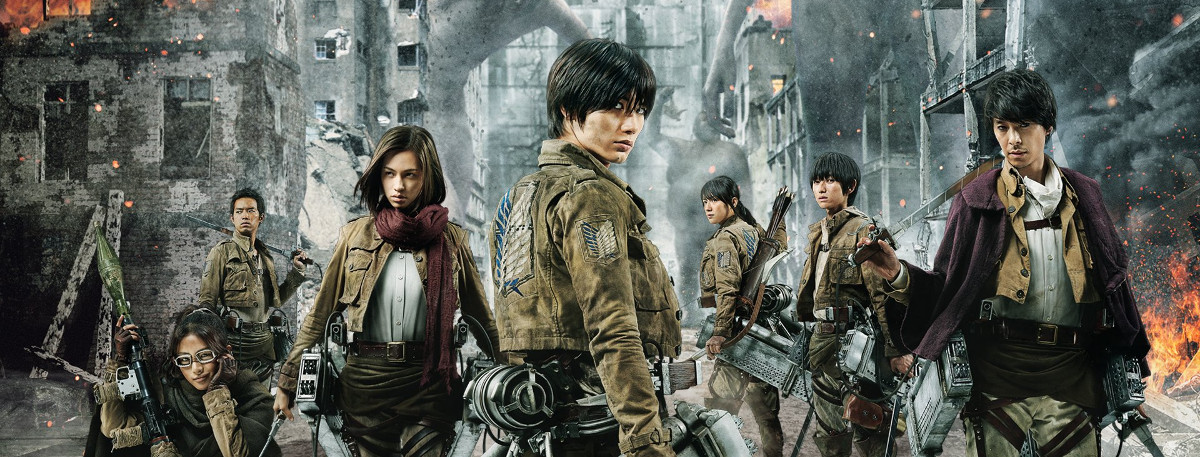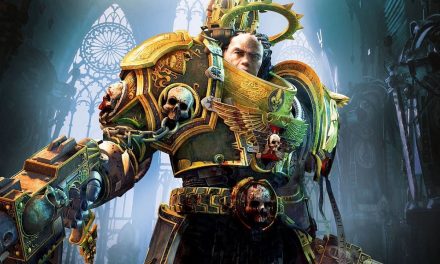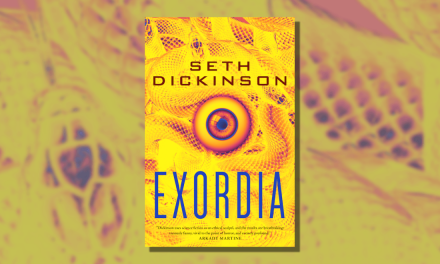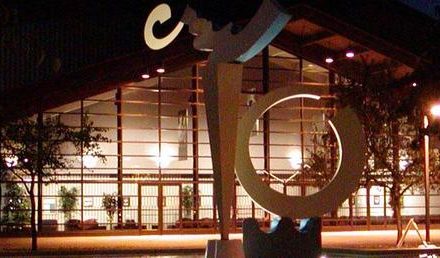Directed by Shinji Higuchi, this two-part movie event from 2015 retold a popular manga and anime series in live-action. I knew (and know) almost nothing about the original story going into the movies, other than it featured humanity versus giant monsters. The short answer is that I was entirely not impressed by this movie, though I recognize that some of that may stem from cultural or demographic differences.
The Plot
In a scenario very similar to Judge Dredd or Aeon Flux, humanity resides behind tall walls, cordoned off from the outside world. One hundred years ago huge, human-shaped monsters attacked the world, without apparent origin or motivation other than hunger. They ate only humans and though the results of the “first titan war” were dire, it provided a safe refuge wherein which our protagonists now reside. Similar to the Hunger Games or In Time, the wealthy are separated from the poor and live in relative luxury, while the rest of humanity is protected and ruled by the iron-fist of military leadership.
As farming communities question the existence of titans and the necessity for the walls, no monsters having been seen in generations, titans attack anew, breaking a hole in the outer wall and terrorizing the farming peasantry who live in the outermost regions.
Fast-forward two years and the poor have had to cram into the middle section of the city, where supplies are limited and the military wields complete control. Numerous attempts to plug the hole in the outer wall have failed, leaving the infantry filled with poorly-armed recruits. A last-ditch effort is made to repair the wall, legendary heroes emerge and teach the protagonists how to kill titans, and eventually the truth of the horrific monsters is revealed. In the end humanity learns that they themselves are the monsters, metaphorically and otherwise, and come to terms with how to move forward as a society.
The Characters
 From my perspective, almost every character was plucked from common anime tropes that I can’t stand – the brooding and reluctant hero, the zany techno-chick, the egoist anti-hero, the drunk wise uncle, the icy love interest with a heart of gold, the ninja archer, and the conniving military commander. The only character development I saw was the female love interest turning into a mercenary and the main hero sacrificing himself for the greater good. Except he didn’t really. More on that later. Everyone stayed functionally flat and unchanging through the entire three-hour saga.
From my perspective, almost every character was plucked from common anime tropes that I can’t stand – the brooding and reluctant hero, the zany techno-chick, the egoist anti-hero, the drunk wise uncle, the icy love interest with a heart of gold, the ninja archer, and the conniving military commander. The only character development I saw was the female love interest turning into a mercenary and the main hero sacrificing himself for the greater good. Except he didn’t really. More on that later. Everyone stayed functionally flat and unchanging through the entire three-hour saga.
The Schlock
Where to start. The entire setting of the movie makes no logical sense. I can buy that advanced technology and machines were either outlawed or destroyed in the great titan war, but the military is so cartoonishly evil in destroying books or any device that uses electricity. Except for some cars. And spotlights. And pneumatic-powered grappling hook systems that are at once both revolutionary new technology and old enough for legendary heroes (who are teenagers) to be excessively proficient with them. There have been plenty of post-near-apocalypse stories where the setting was logical and made sense; this is absolutely not one of them.
Did you know that kicking a 50’x50′ hole in a wall yields enough flying boulders to level multiple cities, kill untold thousands of people, and crash-land everywhere from right near-by to miles away? There are a lot of problems with physics I can ignore in movies, but it seemed like the initial breaching of the wall not only generated new material, it launched these projectiles at insane speeds and angles in a way that just absolutely made no sense. Maybe a little gripe, but it genuinely pulled me out of the movie when I saw what the movie was trying to convey.
So our protagonists, after watching the heroes, start to use the grappling hook systems to move around the city and kill titans who are standing in the way of their mission. At this point I have the same complaint I have with early Spider-Man comics and movies – where the heck are they grappling on to? This is a thread that continues all the way through the movie; at one point they’re standing in what is functionally an open field and still manage to grapple up, up, and away from danger. I’m more than willing to suspend my disbelief, but only so far, and to have this particular point shoved in my face time and time again was too much.
The underlying motivations of the anti-hero are to not kill titans, but to help humanity rise up against the military command which has imprisoned them … by tearing down the walls so more titans can kill more humans? The plan just makes absolutely no sense so long as the great external enemy still exists. Spoiler alert, the original titans were created by the military, who then used the resulting chaos to gain command of civilization. We’ve seen that before and we’ll see it again, it’s a good trope that can be done well. They brought back the titans when the common rabble were starting to get complacent and adventurous, I even buy that. The main legendary character’s plan just makes absolutely no sense as a means to his stated goal. It’d be like Tyler Durden in Fight Club blowing up the Sydney Opera House in order to encourage the appreciation of street art in New York City. The two things are related, but not in anything more than the most tenuous of ways.
Did you know that completely domesticated cows can survive for more than two years in the wild with no human contact, surrounded by monsters that eat flesh? Apparently they can. Also, the titans have terrible senses and so are most active during the day, but are drawn to the sound of human voices. What? Even given that idea, why then do the characters all shout and stage-whisper to each other while in the middle of sleeping titans? Even for a doomed-to-fail mission it just seemed ridiculous with zero logic put into planning or execution.
Immortality. Due to mysterious flashback-ex-machina and hidden super serum, it is discovered that both our main protagonist and the legendary hero can turn into titans at the moment of death, becoming hulking monstrosities that possess their intelligence and fighting prowess; something that is remarked on multiple times by a multitude of characters. These characters, when they transform into titans, recover and regenerate from any wound they received. This completely removes any sense of danger or peril that the story tries to encourage, because two main characters are functionally immortal. They’re never in actual danger from that point forward, though the dramatic music and reactions of the other characters all make it sound like every punch could be their last.
The first movie is an hour and a half long, released in July of 2015. The second half, released in October of 2015, includes a nearly ten-minute recap of the first movie before the opening credits. It makes me feel like the first movie could have been half an hour long and it would have been an improvement. Perhaps it was because the wife and I watched these movies back-to-back (hey, it was a lazy Sunday night), but I don’t recall many of the sequels in my library having much more than a minute or two primer, and then only if the sequel was released years after the first. Can you imagine if Lord of the Rings tacked on ten minutes to The Two Towers to explain the first movie, and fifteen minutes onto Return of the King to explain the three hours of plot that had come before? Of course not.
The Effects
To the movies’ credit, the effects weren’t bad. Huge, instinct-driven titans with oversized mouths were appropriately lumbering but scary, and the gore when they killed their prey (humans) was bloody and visceral, as one would expect – it was neither shied away from nor too gratuitous for what actions were displayed on-screen. I really liked the design of the titans’ mouths, and how each were different.
 The first titan we see in the movie, a truly towering beast which knocks a hole in the outer wall, was well-animated and rendered, but kind of made the rest of the movie feel flat. Here was this awesome, smoke-covered monstrosity that we don’t see again until the very end, left instead with almost boring, dull monsters that don’t have any real agency or wow-factor for the majority of the films. The end fight against the first-seen titan was pretty cool, I’ll admit, but revealing the “big bad” at the beginning seems like a wasted opportunity which reduced the impact of the rest of the film.
The first titan we see in the movie, a truly towering beast which knocks a hole in the outer wall, was well-animated and rendered, but kind of made the rest of the movie feel flat. Here was this awesome, smoke-covered monstrosity that we don’t see again until the very end, left instead with almost boring, dull monsters that don’t have any real agency or wow-factor for the majority of the films. The end fight against the first-seen titan was pretty cool, I’ll admit, but revealing the “big bad” at the beginning seems like a wasted opportunity which reduced the impact of the rest of the film.
My Ignorant Assumptions
I readily admit I am neither an expert on Japanese film history or media culture, and that I wasn’t the target audience of this movie. There was enough backstory given where I had a complete idea of what was going on, save for eye-rolling inconsistencies and character decisions as detailed above, but it was obviously a setting and story translated from one medium (episodic manga) to another (episodic TV anime) to another (movie). It seemed to focus on the “wrong” things from scene to scene, have large pacing issues, and keep character stereotypes intact when they are more fitting to some types of media than others.
It may be that the archetypal characters and the tropes they endlessly portrayed are respected or at least expected in Japanese film, I don’t know. Perhaps it’s something like the stock characters and stories seen in commedia dell’arte, where there are genre-defined roles and responsibilities that the audience are well-aware of, reducing the need for backstory or explanation of why a particular character is acting a particular way. Through my limited exposure with anime (namely Cowboy Bebop, Rurouni Kenshin, and some Hayao Miyazaki) I have become well-aware of many of the tropes displayed in Attack on Titan and know that they are not interesting to me, either as someone who studied theatre or as someone who enjoys watching movies.
Critics and fans seem to have given the films a thumbs-up, though reactions were much more mixed on sites like Rotten Tomatoes, which aggregates reviews and votes from around the web.
In Conclusion
My short answer for this movie is “don’t watch it.” There are other movies which have done different, and more interesting, takes on the same or similar premise, without the annoying and overwrought archetypes these movies brought to the fore. Both my wife and I spent more time discussing flaws with the movie than actually enjoying it, and I think both of us wish a different movie had come out that addressed the themes, even the exact same story, in a better manner. She’s watched far more anime in her life than I, but even she rolled her eyes at most of the characters and situations.
I don’t mean to suggest this movie is without merit, because there are elements and moments that were well-crafted and -portrayed, but they are too few and too far between to justify watching the entire three and a half hour saga of bland overacting. This movie actually makes me less interested in the anime series, because if the filmmakers thought these were the most important parts to translate, I don’t think I could bear to sit through an extended series of the same content.














